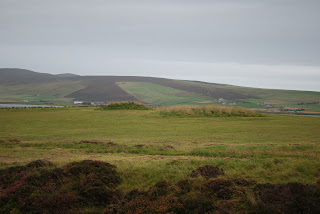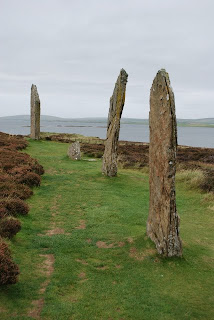Day 21
Today I woke up really early to join the tour to Orkney Islands. We left Inverness 6:00 am, so, well, that was not very funny. It took me a while to get easy, but then I had to remember I was going to Orkney, and that today is my last day traveling, after 10 weeks or so. Tomorrow I must return to London, and in a few days back to São Paulo.
The day was cold, but we did not catch rain, nor the rain has caught us.
Orkney is an archipelago in the north of Scotland, consisting in around 70 islands, depending on what call an island (that’s what they say). There is great concentration of Neolithic, Bronze and Iron age settlements. Apparently there were a whole society running there as far as 5.000 years ago.
I was in a tour, so I did not could get to all the places I wanted, but for this I should stay one week there, I suppose. So, I could reach some of the highlights, and it was not bad.
After a short stroll through Margareth’s Hope, we passed through the little islands of Scapa Flow and Burray, to head to the Mainlands.
Crossing the island, we get to Kirkwall before going to Skara Brae.


Skara Brae
 This is the most complete Neolithic residential site found so far. it is composed of seven houses and a working place, with all the furniture and devices used by the users. There is no register of religious services like burials or bones. The houses have a similar format, although there are two phases of occupation, spanning 600 years of use: from 3100 to 2500 BC. Skara Brae was left intact by his inhabitants, probably for climatic changes, as it is known the temperature droped 10 degree celsius in Scotland’s Bronze age. The site was discovered in 1850 by Vere Gordon Childe, after a storm uncovered one of the turf roofs of one of the houses. It’s been carefully excavated and there is still working in progress going on there. There is a replica of one of the houses that helps to understand the complexity of their houses and living. Amongst the objects found there, there are stone balls and some other decorated stone objects with no much meaning.
This is the most complete Neolithic residential site found so far. it is composed of seven houses and a working place, with all the furniture and devices used by the users. There is no register of religious services like burials or bones. The houses have a similar format, although there are two phases of occupation, spanning 600 years of use: from 3100 to 2500 BC. Skara Brae was left intact by his inhabitants, probably for climatic changes, as it is known the temperature droped 10 degree celsius in Scotland’s Bronze age. The site was discovered in 1850 by Vere Gordon Childe, after a storm uncovered one of the turf roofs of one of the houses. It’s been carefully excavated and there is still working in progress going on there. There is a replica of one of the houses that helps to understand the complexity of their houses and living. Amongst the objects found there, there are stone balls and some other decorated stone objects with no much meaning.



Ring of Brodgar
After that we went to the stone circle called Ring of Brodgar, dated from Neolithic period. Brodgar is estimated to consume impressive 80.000 hours of work, and in its original design had over 60 standing stones in circle. There is a massive number of them fallen on the ground, probably by nature events like thunders. There is something remarkable in Orkney stone circles and it is their sharp angles and straight designs. There are very unlikely shapes for those stones. There is a ditch and there are some mounds around the ring, suggesting some link between them. On the background there are some mountains that are the perfect frame for them. Not far there are some standing stones, marking the path.











The Stones of Stenness
 A few yards from there, there is another stone circle from the same period and sharing some features, called Stones of Stenness. The circle originally had 12 stones, but today there are but a few, but the ones that are still there are very impressive. The stones are from the tallest I’ve seem in Britain, probably the same size from Stonehenge. The menhirs are thin and appear to defy the surroundings. Inside the circle there is an altar with pieces of slabs and a “S” shaped stone notably smaller from the others.
A few yards from there, there is another stone circle from the same period and sharing some features, called Stones of Stenness. The circle originally had 12 stones, but today there are but a few, but the ones that are still there are very impressive. The stones are from the tallest I’ve seem in Britain, probably the same size from Stonehenge. The menhirs are thin and appear to defy the surroundings. Inside the circle there is an altar with pieces of slabs and a “S” shaped stone notably smaller from the others.



Maes Howe
Close to the Stones, a bit northeast, there is the Neolithic passage chamber of Maes Howe. It is a remarkably well preserved chamber which was invaded at some point in the 12th century by Vikings which left their marks there like runic phrases and even a drawing of a dragon. The construction from the internal chamber resemble somewhat the Newgrange passage, without the decoration. From the outside, Maes Howe is much less impressive, but it is not a small mound.
look inside here
The site is aligned to the winter solstice, but in most of December the light enter there in the dawning of the day. There is no register of human remains in these sites apart from a few bones which disappeared. Probably there were never someone buried there. Special features is a triangular stone that would serve to block the passage, but there is no much proof of it.


Kirkwall
After this we went to the city of Kirkwall where I could see the Romanesque cathedral and some pieces in the museum of the city, specially some Pict’s carved stones and a very special whale bone carved by Vikings.




Kirkwall and the whole Orkney Islands are highly suscetible to climate changes, just as it has happened in the past and again in recent years. like now, for instance.





 The journey ended at 21:00hs back in Inverness. It was a very desgasting day, but a lovely one. Tomorrow I will be back to London, where I will concentrate in my return.
The journey ended at 21:00hs back in Inverness. It was a very desgasting day, but a lovely one. Tomorrow I will be back to London, where I will concentrate in my return.






















